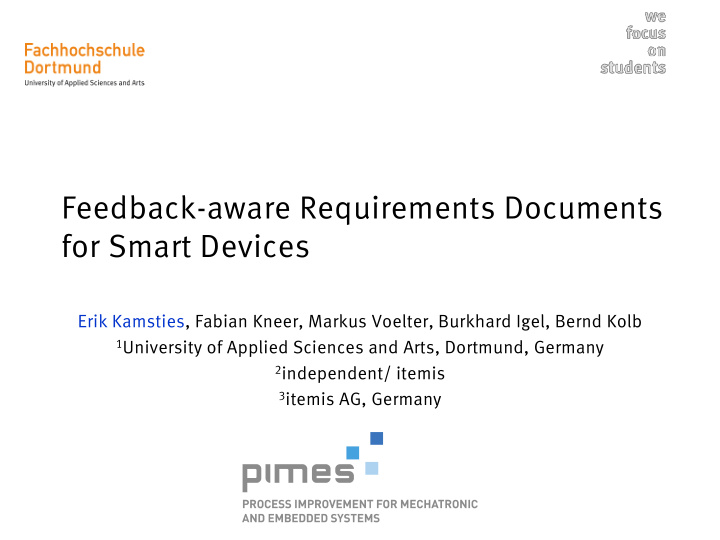



Feedback-aware Requirements Documents for Smart Devices Erik Kamsties, Fabian Kneer, Markus Voelter, Burkhard Igel, Bernd Kolb 1 University of Applied Sciences and Arts, Dortmund, Germany 2 independent/ itemis 3 itemis AG, Germany
Overview • Background • Motivation • Goal and Approach • Representation of requirements – Development Time – Runtime • Requirements Monitoring • Requirements Feedback • Conclusion Kamsties, et al. „Feedback -aware Requirements Documents for S mart Devices“, REFSQ‘14, Essen 2
Background • Smart device are software-intensive systems which – operate autonomously – interacts with other systems over wireless connections – faced with uncertainty in the environment – limited resources (CPU, memory) • Example: eCall adds connectivity to a vehicle [http://ec.europa.eu/digital-agenda/en/ecall-time-saved-lives-saved] [Continental] Kamsties , et al. „Feedback -aware Requirements Documents for S mart Devices“, REFSQ‘14, Essen 3
Motivation • Runtime representations of requirements allow for – reasoning about the requirements at runtime – adapting the configuration of a system according to changes in the environment • Problem: There is no connection between – development time requirements (SRS) and – runtime, dynamic requirements model inside a system Kamsties , et al. „Feedback -aware Requirements Documents for S mart Devices“, REFSQ‘14, Essen 4
Goal and Approach • Bridging the gap between development time and runtime representations of requirements • Engineers: better understanding of environment and users • Users: Better understanding of the system • Approach: – Generate a runtime requirements model out of development time requirements – Monitor requirements and compute reconfigurations – weave feedback from the runtime system into requirements documents Kamsties , et al. „Feedback -aware Requirements Documents for S mart Devices“, REFSQ‘14, Essen 5
Goal and Approach Kamsties, et al. „Feedback -aware Requirements Documents for Smart Devices“, REFSQ‘14, Essen 6
Vacuum Cleaner Example [1] • Vacuum cleaner has two goals – to clean apartment and – to ensure comfortable living • two soft goals – to avoid causing danger to people within the house (avoid tripping hazard) and – to minimize energy costs. • The goal clean apartment can be satisfied by two different realization strategies – clean at night or – clean when empty [1] Bencomo, N. and Belaggoun, A., Supporting decision-making for self-adaptive systems, in REFSQ 2013. Kamsties, et al. „Feedback -aware Requirements Documents for Smart Devices“, REFSQ‘14, Essen 7
Development Time Requirements Kamsties, et al. „Feedback -aware Requirements Documents for Smart Devices“, REFSQ‘14, Essen 8
Development Time Requirements • mbeddr is a domain-specific extension of C programming language for embedded software development • mbeddr supports also requirements which are described with a short title, an ID and a prose description • mbeddr allows for managing requirements: – extensible language – Informal requirements may contain formal concepts (semi-formal requirements) – Traceability and consistency Kamsties, et al. „Feedback -aware Requirements Documents for Smart Devices“, REFSQ‘14, Essen 9
Development Time Requirements • mbeddr is a domain-specific extension of C programming language for embedded software development • mbeddr supports also requirements which are described with a short title, an ID and a prose description • mbeddr allows for managing requirements: – extensible language – Informal requirements may contain formal concepts (semi-formal requirements) – Traceability and consistency Kamsties, et al. „Feedback -aware Requirements Documents for Smart Devices“, REFSQ‘14, Essen 10
Development Time Requirements • mbeddr is a domain-specific extension of C programming language for embedded software development • mbeddr supports also requirements which are described with a short title, an ID and a prose description • mbeddr allows for managing requirements: – extensible language – Informal requirements may contain formal concepts (semi-formal requirements) – Traceability and consistency Kamsties, et al. „Feedback -aware Requirements Documents for Smart Devices“, REFSQ‘14, Essen 11
Runtime Requirements Kamsties, et al. „Feedback -aware Requirements Documents for Smart Devices“, REFSQ‘14, Essen 11
Runtime Requirements Kamsties, et al. „Feedback -aware Requirements Documents for Smart Devices“, REFSQ‘14, Essen 12
Requirements Monitoring • The runtime requirements (i.e., soft goals and contribution links) are connected to assertions in the system • When an assertion breaks, the runtime requirements are reevaluated and a new configuration is computed (on particular conditions, reconfiguration can be delayed) • For this purpose we extended the i* model slightly by the concept of a priority (of a goal) and we extended the i* model evaluation process by Grau et al. Kamsties , et al. „Feedback -aware Requirements Documents for Smart Devices“, REFSQ‘14, Essen 14
Requirements Monitoring Assertion „ No tripping hazard “ breaks, because a person walks in the appartment in the dark. Kamsties, et al. „Feedback -aware Requirements Documents for Smart Devices“, REFSQ‘14, Essen 14
Requirements Feedback Kamsties, et al. „Feedback -aware Requirements Documents for Smart Devices“, REFSQ‘14, Essen 15
Conclusion • The goal of our work is to gain insights into how requirements evolve over time and how the system is actually used. • We proposed an approach to establish the missing link between development time and runtime representations of requirements in the context of embedded systems. • Smart/embedded systems are particularly interesting, as a human operator is often not available to give a confirmation to a system’s decision. Thus the system must decide autonomously. • I have a demonstrator with me to give a practical demo in a break… Kamsties, et al. „Feedback -aware Requirements Documents for Smart Devices“, REFSQ‘14, Essen 16
Recommend
More recommend